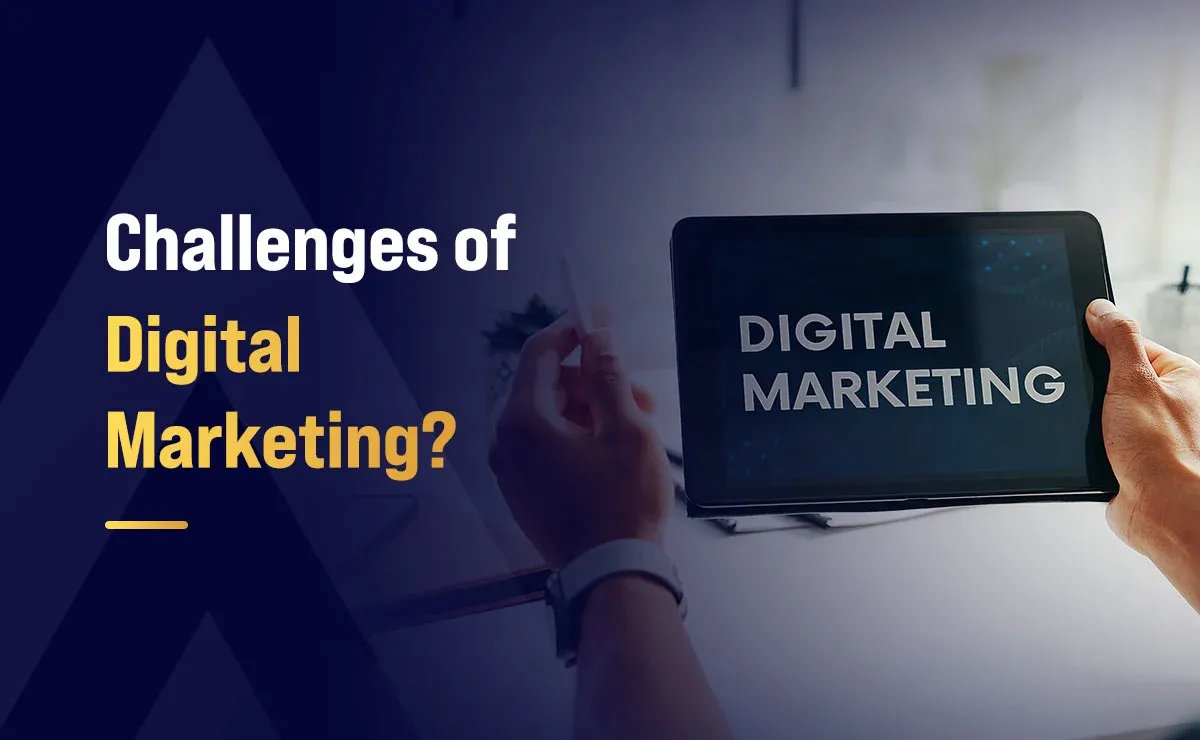What are the Challenges of Digital Marketing?

Digital marketing, while offering immense opportunities in today's hyper-connected world, presents significant challenges for professionals. The fast-paced, ever-evolving scope of digital marketing demands constant adaptation, innovation, and strategic thinking that many traditional marketing graduates lack.
Despite marketing roles attracting 60% of MBA students, there's a widening gap between academic knowledge and practical digital skills needed for success. In this article, we’ll explore the most pressing digital marketing challenges and opportunities to provide actionable insights to help businesses and students navigate this complex field.
Current Digital Marketing Challenges in India

Evolving Technology
Digital marketing technologies are constantly evolving, with new tools, algorithms, and features being introduced regularly. For instance, programmatic platforms that use AI and machine learning to automate ad placements are replacing traditional methods. While these platforms offer efficiency and higher conversion rates, they can be intimidating for marketers accustomed to manual processes.
Solution:
- Embrace automation tools to streamline workflows.
- Stay updated with technology changes and experiment with new platforms.
Talent-Industry Gap
The most significant challenge in the growing field of digital marketing is the growing disconnect between traditional education in marketing and industry requirements. While traditional MBA programs provide theoretical foundations, they fail to equip graduates with the hands-on digital skills needed in modern roles.
The problem is particularly acute as the job market is rapidly shifting toward hiring people who can handle digital first marketing requirements. Such roles require a unique blend of traditional business acumen and digital expertise. The gap between digital education and industry needs hinders the development of competent digital marketing professionals.
Solution:
- Students should choose institutions that have established industry-academia partnership programs to provide specialized digital marketing courses. There are many universities that leverage industry experts as mentors so that students learn the most relevant digital marketing skills according to the current industry requirements.
- Businesses can implement a formal apprenticeship model that transforms recent graduates into skilled digital marketers. This solution helps businesses develop talent aligned with their specific needs while giving graduates practical experience and a clear career path.
Fast-Changing Trends
Marketing trends evolve rapidly, making it difficult to keep up. Success strategies from the previous year might not yield the same results in the current landscape. New social media platforms emerge, algorithm updates disrupt search engine rankings, and audience preferences shift quickly.
The rise of platforms such as TikTok and Instagram Reels has revolutionized brand-consumer interactions through bite-sized video content. Organizations that don't embrace these evolving dynamics risk losing their market position.
Solution:
- Stay informed by following industry news, engaging in digital marketing communities, and experimenting with new formats that align with audience preferences.
Market Competition
There is an immense rise in competition in the market after the advent of digital marketing. Although it connected businesses of all sizes with the global market, it also meant that now small businesses are having to compete with global corporations that have larger marketing budgets, advanced technology, and brand recognition.
These well-established brands often dominate search engine rankings, social media advertising, and digital marketplaces. To capture attention, enterprises must cultivate a distinctive brand persona while generating premium, captivating material that strikes a chord with their intended demographic
Solution:
- Leverage niche marketing strategies, personalized content, and local SEO to enhance visibility and build strong customer relationships.
Data and Security Issues

Data breaches and privacy concerns are a growing challenge of digital marketing technology. The public has grown increasingly cautious about personal information collection and handling. In response, frameworks like GDPR and CCPA have established stringent protocols governing business practices around customer data management.
Additionally, advertising fraud—such as click farms and ad bots—can inflate metrics, leading to wasted ad spend.
Solution:
- Maintain complete openness regarding data gathering and application methods.
- Deploy comprehensive digital security protocols, including data scrambling and protected transaction systems.
- Monitor and adapt to evolving privacy guidelines while ensuring operational compliance across geographical boundaries.
Optimizing Marketing Budgets
With so many digital channels available—SEO, PPC, social media, email marketing, and influencer collaborations—it can be challenging to allocate budgets effectively. Businesses often struggle to determine which channels provide the best return on investment (ROI).
Additionally, evaluating marketing initiatives requires examination of diverse performance metrics, including sales conversion, customer onboarding expenses, and interaction metrics. This requires professionals who will not only analyze these KPIs but also use them to take actionable decisions.
Solution:
- Establish definitive performance benchmarks and implement analytical solutions for campaign monitoring.
- Prioritize high-impact, cost-effective channels like content marketing and email campaigns.
- Regularly review and optimize campaigns to ensure maximum ROI.
Unpredictable Consumer Behavior
Shopping habits and preferences undergo constant transformation, shaped by changing trends, financial circumstances, and innovations in technology. Some users may convert after seeing an ad, while others may need multiple interactions, such as email marketing, social proof, and word-of-mouth recommendations.
This element of uncertainty complicates the development of marketing approaches that connect with target groups. Given that no universal approach guarantees results, brands must utilize evidence-based insights to enhance their methodologies.
Solution:
- Harness analytical tools to discover recurring patterns in shopper conduct.
- Personalize marketing messages to meet individual consumer needs.
- Seek regular feedback from customers to refine strategies.
Bandwidth and Time Constraints
Online promotion demands substantial investment of both time and resources, presenting difficulties for small-scale operations with minimal staffing. Balancing trend awareness and technological adoption while handling routine operations can become overwhelming.
Solution:
- Prioritize high-impact activities that align with business goals.
- Implement automated systems to simplify recurring responsibilities like content scheduling and metric analysis.
- Delegate tasks or outsource to specialists to manage workload effectively.
Crafting a Successful Content Strategy
Building and executing a content strategy that connects with your followers presents numerous complexities. Given the vast amount of existing online material, brands struggle to differentiate themselves. Moreover, producing high-quality content consistently requires time, creativity, and resources.
Understanding what your audience wants and aligning it with your brand’s goals can be tricky; hence, it requires careful planning, creativity, and coordination among team members.
Solution:
- Develop an organized content calendar to arrange and coordinate future content.
- Diversify content formats, such as videos, blogs, infographics, and interactive content.
- Foster teamwork to enhance content development processes.
Creating Relevant Ad Copy
Developing ad copy that commands attention and prompts response poses a significant challenge in today's saturated digital environment. Modern consumers face constant advertising exposure, leaving mere moments to make an impression. Furthermore, all platforms have their own character limits and formatting restrictions.
Standing out in a crowded digital space requires creativity and precision, which is why crafting ad copy that captures attention and drives action is a critical skill in digital marketing.
Solution:
- Focus on benefits and use A/B testing to refine ad copy.
- Customize your ad copy to match each platform's specific format and user base.
- Incorporate striking visuals and direct-action prompts to boost participation.
How to Overcome Digital Marketing Challenges
Below are key approaches to overcoming digital marketing hurdles and ensuring long-term success.
Know Your Target Audience

One of the biggest mistakes in digital marketing is targeting a broad or undefined audience. Marketing initiatives may fail to generate engagement or conversions without a thorough grasp of your customer base.
How to Identify and Understand Your Audience:
- Create Buyer Personas: Develop detailed customer profiles based on demographics, interests, pain points, and purchasing behavior.
- Review Digital Platform Statistics: Employ platforms such as Google Analytics, Meta Business Suite, and LinkedIn Insights to conduct user behavior data analytics.
- Analyze Consumer Response: Customer feedback provides direct insight into consumer desires and preferences.
- Deploy Remarketing Strategies: When visitors engage without converting, target them again with customized advertisements.
Flexible Marketing Strategy
A rigid marketing approach can lead to failure in a dynamic digital landscape. Market dynamics, platform algorithms, and user preferences shift regularly, requiring businesses to maintain flexibility.
How to Build a Flexible Strategy:
- Test and Optimize Campaigns Continuously: Deploy A/B testing to assess various creative elements, titles, and audience targeting approaches.
- Leverage Multi-Channel Marketing: Don’t rely on a single platform—combine social media, email marketing, paid ads, and SEO to maximize reach.
- Redistribute Resources: Channel additional funding toward successful campaigns while reducing investment in underperforming initiatives.
- Track Industry Competition: Observe rival strategies and modify approaches to maintain competitiveness.
Stay Up to Date with Current Trends
Digital marketing practices continue to transform, introducing fresh trends every quarter. Staying updated with industry developments can help businesses gain a competitive edge.
Ways to Stay Informed:
- Follow Industry News: Register for marketing publications, audio content, and email updates.
- Attend Webinars and Conferences: Learn from industry experts and network with peers.
- Deploy Brand Monitoring Solutions: Track industry and brand discussions to spot developing trends.
- Experiment with Trends: Test new trends on a small scale to assess their potential.
Use Media Planning Tools
Media management platforms optimize the workflow of designing, implementing, and evaluating marketing campaigns. These tools help you manage budgets, track performance, and optimize strategies efficiently.
How to Do It:
- Choose the Right Tools: Use platforms like Hootsuite, Buffer, or Google Ads for scheduling, tracking, and reporting.
- Centralize Campaign Management: Use tools that integrate multiple channels for seamless execution.
- Evaluate Results: Utilize performance tracking capabilities to assess campaign effectiveness and spot improvement opportunities.
- Collaborate Effectively: Use tools that allow team members to collaborate in real time.
Market Research
Effective digital marketing is rooted in data-driven decision-making. Companies risk operating on incorrect assumptions without comprehensive market insights.
How to Do It:
- Study Market Players: Examine competitor approaches, advantages, and vulnerabilities.
- Conduct Surveys and Focus Groups: Gather direct feedback from your target audience.
- Use Analytics Tools: Track industry trends and consumer behavior using tools like SEMrush or Google Trends.
- Monitor Social Media: Implement social listening tools to understand the interests of the audiences.
Delegate Media Strategy and Execution
Digital marketing encompasses various responsibilities, from content generation to performance analysis. Proper task distribution ensures comprehensive attention to strategic elements.
How to Do It:
- Outsource Tasks: Engage freelance professionals or specialized agencies for specific needs like visual design or search optimization.
- Build a Skilled Team: Assemble a team with diverse skills to handle different aspects of your strategy.
- Leverage Automation: Streamline repetitive operations like post scheduling and email distribution.
- Set Clear Roles: Define responsibilities and workflows to ensure smooth execution.
Conclusion
While digital marketing offers vast potential for businesses, it also presents notable challenges. However, organizations can successfully navigate these digital marketing obstacles by employing data-focused approaches, maintaining industry awareness, and utilizing appropriate technological solutions.
A flexible marketing strategy, thorough market research, and a deep understanding of the target audience are key to long-term success. Additionally, delegating tasks, utilizing automation, and optimizing marketing budgets can help businesses maximize their ROI.
As the digital landscape continues to evolve, businesses and marketing professionals must remain agile, proactive, and innovative. By embracing change and continuously refining their approach, they can not only navigate the complexities of digital marketing but also gain a competitive edge in today’s fast-paced digital world.





